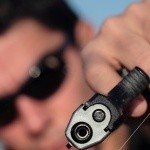
Jose Gonzalez and his fellow gang members beat Richard Holguin the night of Feb. 16. 1996. As Holguin lay on a La Habra street, the 47-year-old was repeatedly hit and kicked before being dragged to a corner where he was left to moan, unable to move. The gang members drove off but returned a few minutes later to find Holguin still down in the street. That's when one gangster got out of the vehicle, walked over to the suffering man and shot him several times.
For Gonzalez's role in the murder of Holguin, he'd like to be paroled today. Not so fast, counter prosecutors.
]
July 6, 2011
OCDA TO OPPOSE PAROLE OF GANG MEMBER FOR ROLE IN UNPROVOKED SHOOTING-MURDER OF 47-YEAR-OLD MAN
SANTA ANA – Orange County District Attorney (OCDA) Tony Rackauckas is
opposing the parole of a gang member for his role in the beating and
shooting-murder of a 47-year-old man. Jose Gonzalez, 32, is currently
being held at Centinela State Prison in Imperial, CA. Gonzalez was
sentenced Oct. 17, 1997, to 19 years to life in state prison for one
felony count of second degree murder and one felony count of assault
with a deadly weapon. He is scheduled for a parole hearing tomorrow,
July 7, 2011, at 1:30 p.m. at the prison before the Board of Parole
Hearings, California Department of Corrections and Rehabilitations.
Orange County Deputy District Attorney Susan Eckermann will appear to
oppose the parole of Gonzalez.Facts of the Crime
On Feb. 16, 1996, Gonzalez, then-17 years old, and several fellow gang
members were consuming alcohol at a house on East Grace Street in La
Habra. Victim Robert Holguin, 47, knew the defendant from the
neighborhood and joined them for drinks. The victim, who was not a gang
member, became severely intoxicated. During the gathering inside the
home, Holguin was punched in the face by one of the gang members after
remarking that a female relative was dating a member of a rival gang.
Later that night, Gonzalez was outside of the home with his fellow gang
members and Holguin. The inmate and his co-defendants began assaulting
the victim by repeatedly hitting him and kicking him as he lay on the
ground. The gang members then dragged the victim to the corner and left
him on the street moaning and unable to move.
Gonzalez and his fellow gang members got into a vehicle and drove away. A
few minutes later they returned to where they had left the victim, who
was still lying on the ground. The inmate and his co-defendants got out
of their vehicle, surrounded the suffering victim, and then one of the
gang members shot Holguin multiple times with a firearm. The defendants
fled the scene.
During the murder investigation, an examination of the body revealed
that the victim had 29 entry or exit wounds and the asphalt around the
body was riddled with pock marks and shell casings. Gonzalez and his
codefendants were later arrested by the La Habra Police Department.
Gonzalez was convicted June 18, 1997, and was sentenced Oct. 17, 1997.Lack of Rehabilitation and Unreasonable Risk of Danger
The People explain in a 2011 parole opposition letter that “the
commitment offense is calculated, callous, and excessively violent as
well as completely unjustified.” The letter continues that “a person
with this kind of mob mentality violence.prior arrests, violations of
probation, absconding from probation, criminal associates, and
institutional violence and misconduct is not someone we should send out
into society and expect to live a peaceful life.”
Gonzalez poses an unreasonable risk of danger if he is allowed to
re-join society and his prison record shows no sign that he has been
rehabilitated. He continues to exhibit violent behavior and he has been
cited for major prison rule violations while incarcerated including
assaulting an inmate and possessing a razorblade. He fails to take
responsibility and denies his involvement in the crime. Gonzalez also
continues to acknowledge and maintain relationships with criminal street
gang members. His lack of remorse, continued association with criminal
street gang members, and failure to take responsibility demonstrates
that he poses a continued danger if released into the community.

OC Weekly Editor-in-Chief Matt Coker has been engaging, enraging and entertaining readers of newspapers, magazines and websites for decades. He spent the first 13 years of his career in journalism at daily newspapers before “graduating” to OC Weekly in 1995 as the alternative newsweekly’s first calendar editor.

